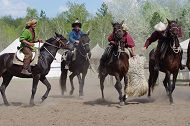Situated at a distance of an hour drive from Orosháza, Ópusztaszer in Csongrád county, is one of the most significant sights of the country.

The National Historical Memorial Park is an open-air ethnographic museum, skansen and ideal destination for excursions, which was established in 1982 at Ópusztaszer, situated in Csongrád county. The best known piece of art exhibited is the circular panoramic painting of Árpád Feszty with the title „Arrival of the Hungarians”.
Visitors can find the main attraction of the Memorial Park placed in the rotunda: the circular panoramic painting of Árpád Feszty. The 120 metres long, 15 metres high and 38 metres in diameter painting, forming a circle, presents an imaginary episodes of the Hungarian Conquest 11 centuries ago.
According to the information from Wikipedia in the rotunda visitors can watch other permanent exhibitions, too. The exhibition with the title „Circular panoramic paintings of the world” presents 34 paintings of the 19th century, when the circular panoramic paintings flourished. The Panoptikum exhibits 22 wax figures of the most important personalities of the Hungarian history. The Promenade presents the golden age of the Monarchy, end of the 19th century. Authentic shops of a city and small town are modelled, with wax figures wearing clothes of the time. The History of the Park is an exhibition presenting the history of the Memorial Park. Szer monastery presents the history of the former monastery through archaeological records. The exhibition „Allied nations” presents the history of the Finno-Ugric language family through pictures.
The „Open-air ethnographic collection” is one of the five skansens of the country. It includes 19 buildings and three open air exhibitions. This department was built in 1978 and has been developed ever since. The buildings present the different regions of the country, visitors can get a view of the 19th century village and farm life. A wide variety of crafts are presented, a school, a post office, a windmill, mini railway and a bakery. A collection of vehicles and agricultural machines is also presented.
In the park visitors can find the Forest and the men exhibition, placed in a yurt shaped pavilion. This exhibition presents the relationship of forest, trees and men. This cultural historical exhibition is unique in the country. Opposite the yurt there are is an ecumenical chapel with two towers. The yurt with crown is another yurt shaped building. On the tree rings of a huge tree from 200 BC and died in 1956, crucial years of Hungarian history are carved. The historical events are also presented by models.
The nomadic park brings us the world of Eurasian steppes with yurts and winter shelters. Equestrian shows are also presented. A specialised exhibition presents the relationship between men and water, activities like wood processing, ship building or fishing. With the help of special light and sound effects visitors can get a real experience of the big flood at Szeged, in 1879. The findings of archaeological excavations going on since 1970 as well as the ruins of the old monastery are also exhibited in a place called „romkert” (=garden of ruins).
On the territory of the park there are numerous monuments: Árpád Monument; Árpád-liget in memory of the Hungarian Conquest; military memorial, which commemorates the battles of more than a thousand years; memorial stone of counties, which commemorates the first meeting of the tribes on the newly conquered land; traditional gate of Szeged with relieves; the monument of land reform in 1945 and the agricultural monument.
The park also disposes of a nature trail and playground.
In addition to the above mentioned permanent exhibitions and monuments, Ópusztaszer offers a wide range of programmes, too.












